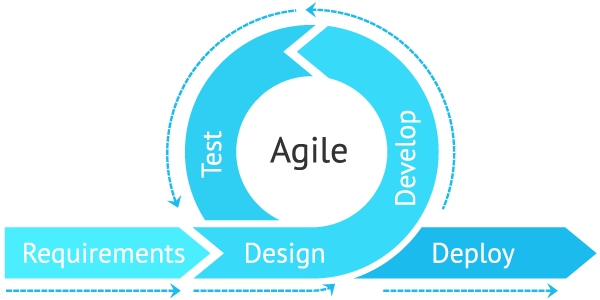There are many different software development philosophies, but the two most popular are waterfall and agile development. The waterfall method is the traditional linear development approach that has been around for decades, whereas agile is a newer iterative approach that emphasizes the rapid delivery of working software and customer feedback loops.
Let's look at the differences between waterfall and agile methodologies and how you can decide on the best option for your project.
The Waterfall Methodology
The Waterfall Methodology is a linear and structured approach to project management. The software development life cycle (SDLC) consists of steps with formal hand-offs from one stage to the next. For example, a customer may need to approve the requirements before the design process begins, and then approve designs before development begins.
A typical sequence of steps might be:
Gather the requirements.
Design the user interface.
Write code and unit tests.
Perform end-to-end tests.
Perform acceptance tests.
Fix any bugs that arise.
Deliver the finished product.
You can think of waterfall development as a NASA project. There's a lot of careful planning and documentation at the beginning and diligent execution of the steps needed to complete a robust final product. There are checklists and approvals required at each stage to ensure that the project is on track and there's a big (and risky) launch at the end.
The waterfall methodology is typically used by larger enterprises with a crystal clear idea of what they want to build. For example, an e-commerce business may wish to create an internal inventory tracking tool with a very specific set of features. Since the scope of the project is unlikely to change, the waterfall methodology provides greater visibility.
Pros
There are detailed product requirements and documentation for new programmers to onboard quickly, and everyone knows what’s next.
Progress is easy to measure since you know the full scope of the project at the very beginning. You know exactly where you are in the process.
Documentation provides a clear scope for the project, enabling managers to communicate budgets and timelines to stakeholders.
You can develop different systems in parallel since you know how the entire system will come together in the end.
Cons
It might be challenging to outline all of the requirements at the beginning of the project, especially if you’re a startup without product-market fit.
There's minimal collaboration with customers, so there’s a risk that they will be surprised at the end with a product they didn’t expect.
Testers report issues and bugs later in the process, which means that there can be a lot of rework fixing them at the very end.
Tldr; Waterfall development works best when there's a low level of uncertainty and a well-defined plan of action. You may also use the approach if your team isn't familiar with agile concepts.
The Agile Methodology
The agile methodology is an iterative approach to development. The goal is to rapidly and continuously deliver working software so customers can provide feedback. Rather than maintaining a rigorous schedule, development work is time-boxed into "sprints" with a running list of deliverables that are prioritized based on their business value.

The Agile Methodology is a Series of Sprints (Above) - Source: DevCom
Many startups use agile development because they don't always know the full scope of their product at its onset. For example, they might try one idea and pivot to another if it doesn't gain traction among customers. They use the agile methodology to learn what customers want through the continuous delivery of working software.
While projects with a clear scope could use the agile methodology, there tends to be less visibility in terms of time and budget. The agile approach can also lead to the "piecemeal effect" that occurs when pieces of code are defined and added to an existing application where they may not fit as well as they would have with better planning in advance.
Pros
Customers have a voice throughout the entire process, and they tend to be more satisfied with (and invested in) the result.
You can release working software more quickly into the market, which could mean earlier revenue or user uptake.
It's much easier to pivot to a different set of requirements if the initial concept wasn't working since you always have a working product.
There's no big launch at the very end that could be risky—you're constantly launching small pieces of code and getting feedback in real-time.
Cons
There's a greater possibility of "feature creep" since the requirements are more fluid. That is, you could miss deadlines by constantly tacking on new features.
Frequent refactoring may be necessary since the full scope is unknown at the onset of the project. If things change, you may need to go back and update code.
Projects may go over the time or budget allocations since there's a less defined schedule—it’s more of an ongoing process.
Tldr; Agile development is ideal when there's a high level of uncertainty. In addition, agile development tends to yield creative solutions to a problem that may not have been obvious at the onset of the project.
Choosing the Best Approach
How do you choose between waterfall and agile for your project?
The important thing to remember is that the decision between agile and waterfall methodologies isn't binary. That is, you can blend elements of both approaches to get the best of both worlds. For example, you might plan out the entire application to provide stakeholders with an estimated time and cost, but be open to changing roadmaps along the way.
There are several factors to consider:
Customer relationship. Contractual customer relationships contain well-defined expectations for a project to be successful. On the other hand, collaborative customer relationships share responsibility for the project's success with evolving expectations.
Team dynamic. Development teams that aren't familiar with agile concepts, like scrum, may struggle to implement solutions. In that case, it might be better to stick with the known processes unless there's adequate time for training and learning.
Project uncertainty. Projects with a high level of uncertainty can cause issues when using waterfall methods since it's not as conducive to changes. Agile methodologies provide a lot more flexibility and are easy to change over time.
There is no "right answer" when deciding between the two approaches—it depends on your team and project. That said, there are several factors that you can use to make the decision.
The Bottom Line
Waterfall and agile are two popular software development methodologies with their own sets of pros and cons to consider. If you have a clear scope, waterfall development can provide greater visibility and a clear deliverable. If your scope might change over time, agile development enables you to learn as you go and produce the best final product.
If you need help planning your application development, contact us to schedule a free consultation and learn how we can help!

Greg Cargopoulos
Marketing Lead

